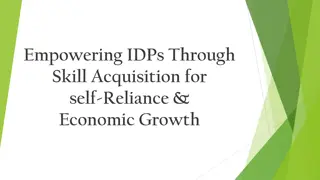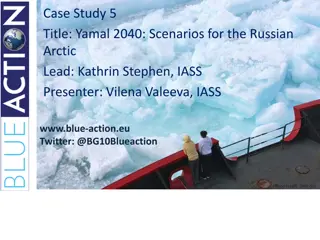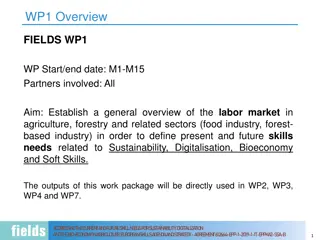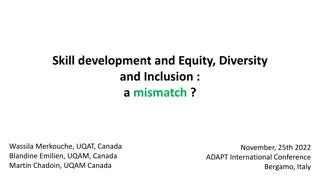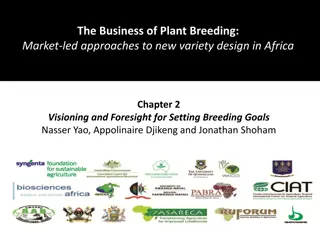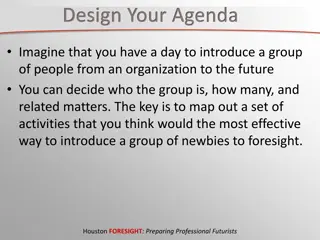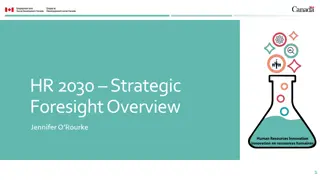ETFs Foresight Approach to Future Skill Needs in Economic Sectors
European Training Foundation's study focuses on analyzing future skill needs in selected sectors using an innovative method that combines big data analysis and traditional techniques. The study aims to support education and training policies by understanding how drivers of change impact jobs and skills. Quantitative steps involve desk research and big data analysis, while qualitative steps include workshops and interviews with stakeholders. The study covers sectors like agri-business, automotive, agri-tech, energy, and healthcare in various countries.
Download Presentation

Please find below an Image/Link to download the presentation.
The content on the website is provided AS IS for your information and personal use only. It may not be sold, licensed, or shared on other websites without obtaining consent from the author.If you encounter any issues during the download, it is possible that the publisher has removed the file from their server.
You are allowed to download the files provided on this website for personal or commercial use, subject to the condition that they are used lawfully. All files are the property of their respective owners.
The content on the website is provided AS IS for your information and personal use only. It may not be sold, licensed, or shared on other websites without obtaining consent from the author.
E N D
Presentation Transcript
ETFs Foresight approach to analyse future skill needs in selected economic sectors Ummuhan Bardak, 26 November 2021 EU Conference on modelling for policy support
OBJECTIVES OF THE ETF STUDY The EuropeanTrainingFoundation is an EU agency that supports European neighbourhood countries in improving their human capital development, in the context of the EU's external relations policy In modern economies, continuous innovation is crucial. Yet, to take advantage of new technologies, it is necessary to have a suitably trained workforce The study aims at supporting policies in education and training by exploring how drivers of change affect jobs and skills needs in selected sectors (from reshaping the needed skills set to the emergence of new professions) and document how companies meet their skills needs
A NEW METHODOLOGICAL APPROACH Drivers of change are acting now, but effects on labour market will be seen in the future Given the anticipatory nature of the study, one cannot rely only on traditional methods such as interviews with experts (qualitative) or the analysis of job postings (quantitative) So far, the methods has been applied in the countries/sectors: ETF, with the support of Erre Quadro srl and Fondazione Giacomo Brodolini, developed a combined methodology for skills foresight MOROCCO: Agri-business TURKEY: Automotive ISRAEL: Agri-tech ALBANIA: Energy TUNISIA: Energy (ongoing) UKRAINE: Healthcare (ongoing) The innovative element is adding big data into picture and combining different but complementary techniques
QUANTITATIVE STEPS 1. Desk research: study of economy and labour market statistics, LFS employment data for the sector. 2. Big Data analysis: use bespoke text mining software to extract emerging signals and correlations from thousands of patents, scientific papers, reports It allows identifying factors shaping future demand, i.e. Drivers of change Innovative technologies that are likely to be used and use them to foresight the need for related skills, competences and occupations (by comparing/ matching these technologies with the associated occupations and skills listed in the databases of ESCO and O*NET)
QUALITATIVE STEPS 1. Workshop(s): governmental institutions, academia, research, public organisations, private associations, NGOs with 30-60 representatives from 2. Face to face interviews: with selected actors from the sector of two types: Stakeholders (sector associations, public authorities, experts, etc.) More innovative companies Due to Covid-19 restrictions, workshops and interviews for four countries have been held online
CHALLENGES AND LIMITATIONS Text mining limited to searches in English (so far) Small number of bilateral interviews with companies (depends on the budget and timing) No indication of the scale or volume of changes in jobs and employment (e.g. how many extra electrical engineers will be required ) Innovations not patented or non-technological innovations are less represented in the results The methodology has to be further tested in economic sectors with more service orientation (e.g. tourism) where the main change drivers are other socio-economic factors, rather that technological advancements
ADVANTAGES, INSIGHTS AND BEST PRACTICES Big data anticipates future skill needs / occupations and connects them directly to real data on trends of change in a way that would not be possible otherwise Results are naturally aligned with standardized classifications (e.g. ESCO, O*NET) The methodology allows detecting also: i. emerging types of competences and combinations of them (e.g. T-shaped profiles) ii. emerging jobs, not included in ESCO or other db (thus providing insights for update) iii. traditional jobs for which new technologies create a renewed demand Quantitative and qualitative steps strengthen and compensate each other; e.g. big data spots drivers shaping future needs, interviews reveal factors that facilitate or inhibit the transition and provide insights on the ability of the education system to meet demand For more info: ummuhan.bardak@etf.europa.eu



